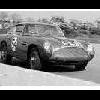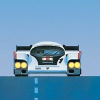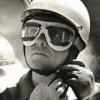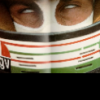Why was Monza 1971 the fastest F1 race over 30 years. Of course it's a high speed track but why was it not faster the following years?
Why was Monza 1971 the fastest race?
#1

Posted 16 July 2015 - 16:02
Advertisement
#2

Posted 16 July 2015 - 16:11
1971 was the last time they raced on the classic Monza circuit....then the 'elf 'n safety gang added chicanes everywhere......
#3

Posted 16 July 2015 - 16:40


The first is the situation during 1955-1971, the second shows the first chicanes added to the track layout.
#4

Posted 16 July 2015 - 17:07
Thanks.
#5

Posted 16 July 2015 - 17:07
the 'elf 'n safety gang added chicanes everywhere......
Same thing happened in '34, with all the straw bale chicanes. Took well over 4 hours to complete the race.
#6

Posted 16 July 2015 - 17:36
And Silverstone got the chicanes as well...
#7

Posted 16 July 2015 - 18:37
ah okay thank you!
#8

Posted 16 July 2015 - 18:48
Excellent graphic comparison.
I should add, which I neglected in my rush to post, that these are from TheRacingLine.net's circuits database. A link is in my signature.
#9

Posted 16 July 2015 - 19:42
Same thing happened in '34, with all the straw bale chicanes. Took well over 4 hours to complete the race.
I think the changes in 1934 were a bit more drastic than a few straw bale chicanes!
#10

Posted 16 July 2015 - 22:11
I think the changes in 1934 were a bit more drastic than a few straw bale chicanes!
LOL, yes. Quite drastic.
#11

Posted 17 July 2015 - 10:56
What was the reason for adding the chicanes to Monza in '72? Was it a reaction to Rindt's shunt the previous year? Was it a decision by the organisers and / or GPDA? I assume that the Ascari chicane changes were permanent so every race outside of the GP from '72 onwards ran on the new layout.
Edited by nmansellfan, 17 July 2015 - 10:59.
#12

Posted 17 July 2015 - 11:33
The organisers. The aim was to cut lap speeds by about 20 mph but the drivers weren't impressed when they got there, considering that they were too narrow - this led to the first chicane being bypassed on the opening lap of the race and a no-passing rule at the second (again for the first lap only).
Rindt's crash, while perhaps a factor, was of course in 1970, not 1971.
#13

Posted 17 July 2015 - 11:50
Thanks for the info, Vitesse. I realised I had typed '71 instead of '72 for when the chicanes were added, but forgot to edit the info about Rindt's crash.
So the drivers were aware that the chicanes would be added for '72, but didn't know what they were like until they got there? Imagine the uproar today if a track inspection and approval hadn't been done months prior!
#14

Posted 17 July 2015 - 12:01
Either in the preamble to the report on in his 'Reflections' on the event. Or both.
I doubt that Rindt's death had anything to do with it.
#15

Posted 17 July 2015 - 13:28
What was the reason for adding the chicanes to Monza in '72? Was it a reaction to Rindt's shunt the previous year? Was it a decision by the organisers and / or GPDA? I assume that the Ascari chicane changes were permanent so every race outside of the GP from '72 onwards ran on the new layout.
Breaking up the slip-streaming battles, which were deemed too dangerous with ever escalating speeds. Same happened at Hockenheim, Pergusa, all the great slip-stream battlegrounds. Many exciting finishes were lost, but probably the right thing to do.
#16

Posted 17 July 2015 - 14:19
In Continental Notes the month before, he said both that it was to slow the cars down and to prevent the cars bunching. I take that as DSJ-speak for "a lot of muddled thinking by those involved". The race report was sub-titled: "Deadly Dull for Monza". DSJ was not impressed.
Autosport (27th July) said that the GPDA had asked for chicanes to slow the cars down. They said that the positioning of the chicanes had caused problems as the Park authorities would not allow any of their "precious trees" to be cut down. Motoring News also said that the changes had been prompted by the GPDA. If so, it might have influenced DSJ's view because he was not a fan.
In case anybody doesn't know, the first chicane was created by placing rubber cones along the start/finish straight as had been done in the days of the road/track combined circuit. The cars exited the Parabolica and raced to the right of the consent did a sharp left-right to join the road circuit shortly after the end of the pits. A row of straw bales was placed to prevent a car from continuing onto the banking if the driver failed to make the chicane. The start by-passed this chicane; the grid was to the left of the codes on a section of track not otherwise used.
#17

Posted 17 July 2015 - 22:25
I assume that the Ascari chicane changes were permanent so every race outside of the GP from '72 onwards ran on the new layout.
Not quite. For example the 1000 km sportscars race was held on the "original" ( ie : sans chicanes ) layout until at least 1973 included. Which is why in 1973 François Cevert's fastest lap in the Matra 670 was 1.29.9 , whereas the same year at the Grand Prix Jackie Stewart set the lap record at 1.35.3 ( cars were of course with comparable 3 liters engines)
#18

Posted 19 July 2015 - 13:29
Thanks for the info, guys.
Yes you're definitely right, Philippe - in fact looking at the Racing Sports Cars website, the track appears to have been able to be raced in the 1955-71 configuration all the way up to the 1976 Monza 4 hours, as J.P. Jarier's fastest lap was 1.29.6 (2.63 sec faster than pole position by Jochen Mass in a Porsche 936!)
Returning to HistoryFan's original post (sort of), were there any speed traps in use at Monza during the '71 GP weekend? I couldn't see any reference to top speeds in the Motor Sport report - I've always wondered if by '71 those early winged cars had overhauled the top speeds the pre-wing '67GP cars were reaching at Monza, Spa etc. Curva Grande must have been only have needed a dab of brake for the fastest and bravest drivers by then?
#19

Posted 19 July 2015 - 18:09
Not quite. For example the 1000 km sportscars race was held on the "original" ( ie : sans chicanes ) layout until at least 1973 included. Which is why in 1973 François Cevert's fastest lap in the Matra 670 was 1.29.9 , whereas the same year at the Grand Prix Jackie Stewart set the lap record at 1.35.3 ( cars were of course with comparable 3 liters engines)
Fastest practice/Q time for the 1972 1000km was 1.24.75 for the Peterson/Schenken Ferrari (almost F1 speed, like Ferraris and Matras often showed on the fast circuits in those years) - what were the practice/Q times the following years?


















